For SaaS companies, content marketing provides a way to fill the sales funnel with qualified leads. Of course, the primary purpose is always to communicate valuable and important information to the customers. But SaaS companies like Marketo understood the importance of communicating this information in a way that turns the target audiences into prospects, and prospects into paying customers. Established in 2006 and recently acquired by Adobe, Marketo is a marketing automation software that has built itself into a tech giant over the years. It was, in fact, one of the companies that started out when the SaaS revolution was relatively new. Given that it is a foundational SaaS business, it would be interesting to examine the role content marketing played in its success. And this is exactly what we’re here to do. In this content marketing case study, we take a look at Marketo’s content marketing strategy, and how it grew into the multi-billion dollar SaaS company it is today.
TL;DR Here’s a quick summary video of this article.
Marketo’s Content Marketing Case Study: What is the Marketo content marketing strategy all about?
- SEO all the way
- A well-categorized Resource Center
- Marketo Blog
- Thought leadership content through CMO Nation
- Marketo Success Kits
- Building a community with Marketing Nation
- Customer stories as case studies
- Webinars and events
- Marketo’s social media presence
- Marketo University
What we learned from Marketo content marketing strategy

Marketo – Story of growth
In 2006, Jon Miller, David Morandi, and Phil Fernandez joined forces to build a one-of-kind SaaS product that was exclusively dedicated to the needs of marketing professionals. Presently owned by Adobe, Marketo is a marketing automation software that makes it easier for B2C and B2B marketers to execute personalized and automated marketing campaigns across multiple channels. It simplifies the targeting of qualified leads and aids marketing professionals in leveraging lead-to-revenue opportunities.
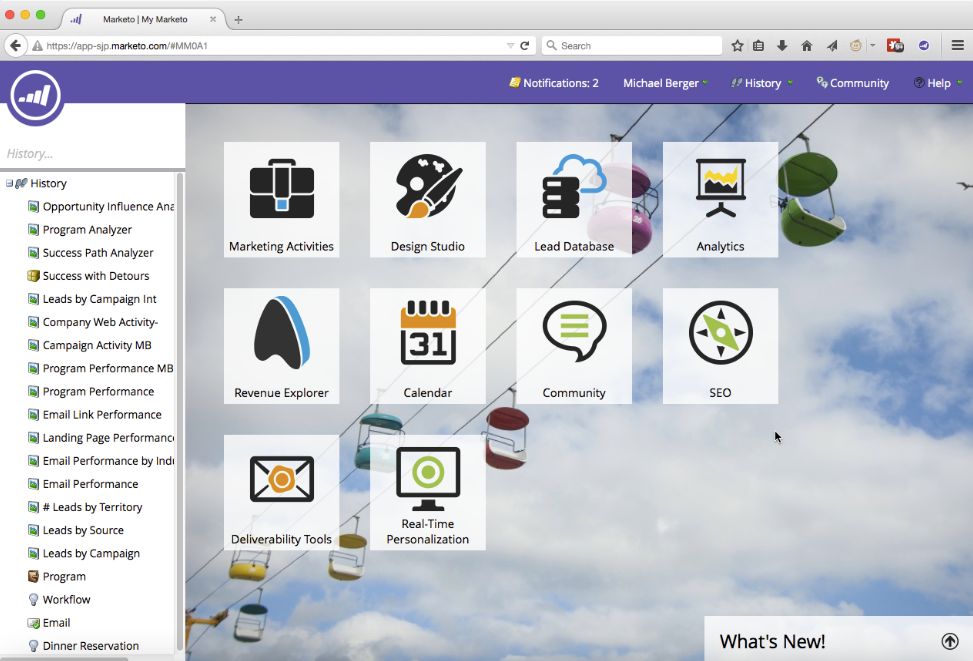
During the time of Marketo’s inception, capital investments in martech were unheard of, since marketing was largely seen as a cost center. Marketo founders decided to change that narrative. But they were faced with the challenge of convincing marketers that they could get tangible value from using their technology. To make the purchase easier for the customers, they decided to take the SaaS route at a time when the concept was still new. They also cleverly positioned themselves as an affordable and easier alternative to Eloqua, which was already an established player in the game. From there, the company gradually built itself into the tech giant it is today.
- 2011: Marketo made it to the list of Forbes’ Most Promising Companies
- 2013: It went public
- 2014: Marketo launched the industry’s first Engagement Marketing Platform
- 2016: Acquired by Vista Equity Partners for $1.6 billion
- 2018: Sold to Adobe for $4.7 billion for a whopping 3x gain

Marketo’s Content Marketing Case Study: What is the Marketo content marketing strategy all about?
Being one of the older players in the SaaS space, Marketo leveraged SaaS content marketing at a time when the concept was still in its nascent stages. In this content marketing case study, we take a look at the different content channels and strategies that helped Marketo scale the heights of success.
TL;DR here’s a short video with the key points from this content marketing case study.
1. SEO all the way
When Marketo was launched in 2006, SEO was still a pretty new concept. Google had just come out with Google Analytics and Webmaster Tools (now known as Google Search Console), and marketers were running experiments in the SEO world. At this time, Jon Miller, the co-founder of the company and the brain behind their content marketing plan, started leveraging content-led SEO techniques which helped them fuel their growth.
As CMO, Miller used classic search engine optimization techniques to find potential users. He built a phenomenon blog where he wrote about macro trends dominating the market and more. Even though the Marketo team did not have anything to sell at the time (their product was still under development), they found that they could provide useful resources to educate their prospective users. This SEO-focused approach allowed the company to establish its presence and build authority among the audience even before officially launching the product. And when they were launch-ready, they already had a list of 50 potential buyers, including names like Thompson Reuters and Colorado-based Simplified.
2. A well-categorized Resource Center
If you’ve read our case study on HubSpot’s content marketing strategy, you’ll notice that the one thing that connects all successful SaaS companies is a well-planned resource center. Marketo’s resource center is categorized in a way that gives visitors all the information they need at their fingertips. There’s an option to jump to specific types of resources, and the type of assets on offer are also many, from definitive guides, articles, and cheat sheets, to infographics, videos, worksheets, and e-books. You can also filter through the resources based on topics, like content marketing, lead management, lead scoring, marketing automation, and more.
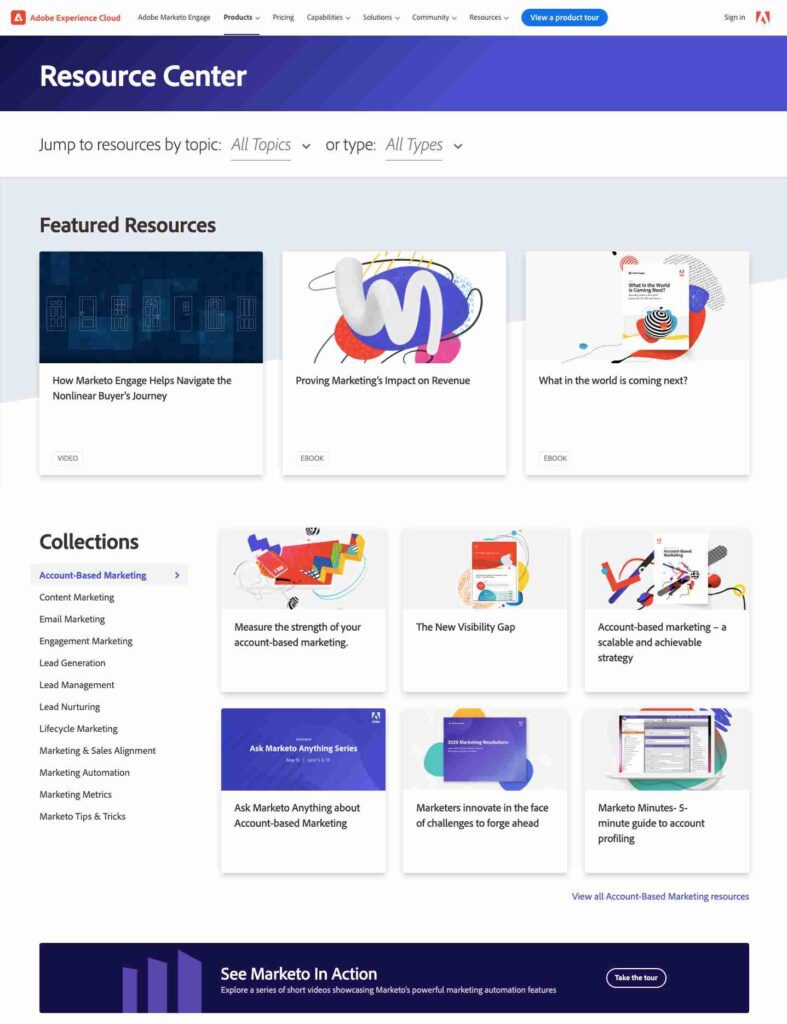
The Marketo resource center is focused on search and discovery. At the same time, it guides the visitors with the best topics and featured collections, which keeps them interested in what they have to offer. They’ve also taken care to design an optimized page for each resource asset in the resource center, allowing the visitors to continue their research.
3. Marketo Blog
The thing that propelled the Marketo content marketing strategy to success was its blog. At the time of its establishment, Jon Miller was an active blogger, who built the blog from the ground up. He played an instrumental role in building a network of people that were familiar with Marketo as a brand, even before they had launched a product. Here in the Jon Miller archives, you’ll find some of the foundational content that went on to establish Marketo as a leading brand. The blog content covered a wide variety of topics from lead management, nurturing, and demand generation to marketing automation and modern marketing. Miller also made sure to do thorough internal linking and use other classical SEO techniques while building the blog.
Even though product-led content marketing was not discovered as a concept at the time, you can find some instances of product-led marketing in Miller’s blogs. This blog post, for instance, discusses the rising importance of marketing platforms and subtly places Marketo as a “Marketing First” platform that can help businesses master marketing. His formula was simple – writing well-researched articles addressing a customer pain point, and intelligently offering the product as the solution.
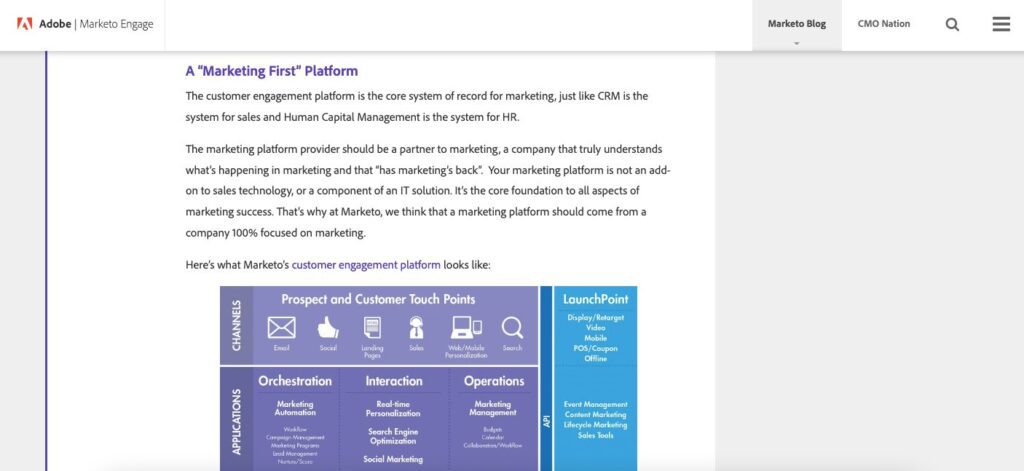
The foundations laid by Jon Miller are still followed today, even though the Marketo blog has evolved with time. The blog is extremely well-segmented and navigating to a topic of choice is easy from the blog menu. Even though the technique of product-led content marketing is not used with every blog piece, they make sure to write well-researched articles that provide tangible value to the readers.
4. Thought leadership content through CMO Nation
When you reach Marketo’s blog page, you’ll notice another tab titled CMO Nation. This is where you’ll find thought leadership content by some of the very best in the marketing industry. The purpose of this page is to provide a learning hub for marketers, where they could gather creative insights and learn more about the future of marketing, besides the current state of the industry. While the focus of the Marketo blog is on solving the customers’ problems, CMO Nation does the job of striking conversations with the audience.
Here is an interesting example of great thought leadership content from Jill Rowley, Marketo’s Chief Growth Advisor. This insightful article challenges the way you think about inbound marketing.
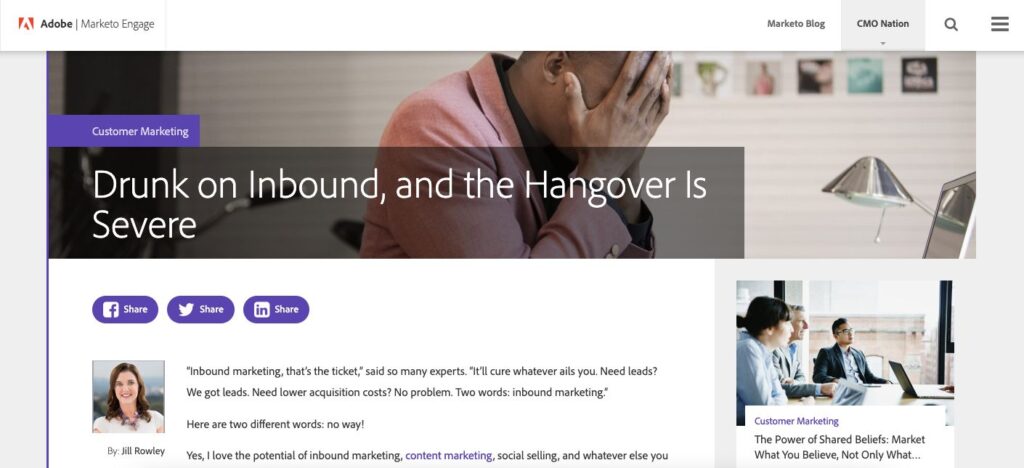
Marketo understood that if it wants to stand out from the crowd and establish its brand authority, it has to challenge the conventional methods of thinking about marketing. They built thought leadership content on topics that their audience would find interesting and made sure that every piece of content is unique, engaging, and well-researched.

5. Marketo Success Kits
When it comes to providing the audience with useful resources, Marketo leaves no stone unturned. The Marketo Success Kits is an excellent example of this. Each success kit is a compilation of cheat sheets/worksheets, blogs, webinars, case studies, and everything one might need on a topic. All the resources available in a success kit help the user in achieving a certain objective.
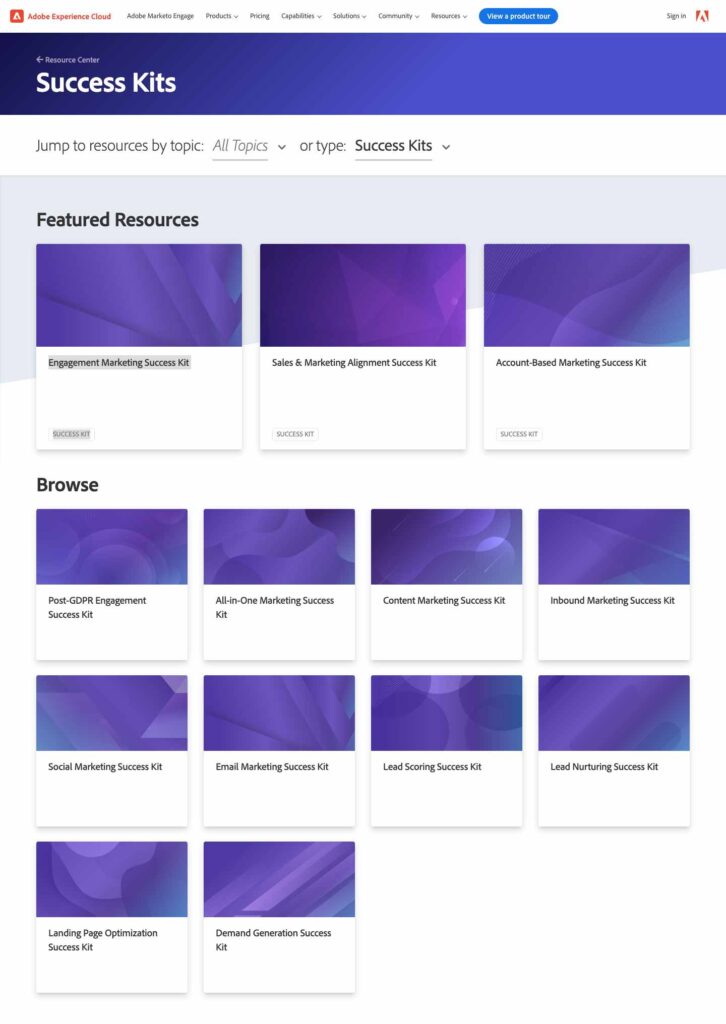
Take this Lead Scoring Success Kit, for example, which is aimed at helping the audience acquire more qualified leads, greater conversions, and a revenue boost. The success kit contains worksheets, guides, blogs, eBooks, and webinars to aid the reader with each step of the lead-scoring process. Although these resources are already available on the website, their compilation in success kits makes it easier for the audience to find relevant topic-related information in a single place.
This is an excellent content marketing strategy to do more with the same content. Note that they are not creating any new content with these success kits, but repurposing their material to make it more relevant for their users.
6. Building a community with Marketing Nation
To allow their users to get the most out of their product, the company developed a community platform known as Marketing Nation. This is a space where users can ask questions, share their best practices and help each other get the most value out of the product through discussion, documents, videos, and more. This is also the space where Marketo shares its product release notes, so the users are able to find all the product-related content in one place.
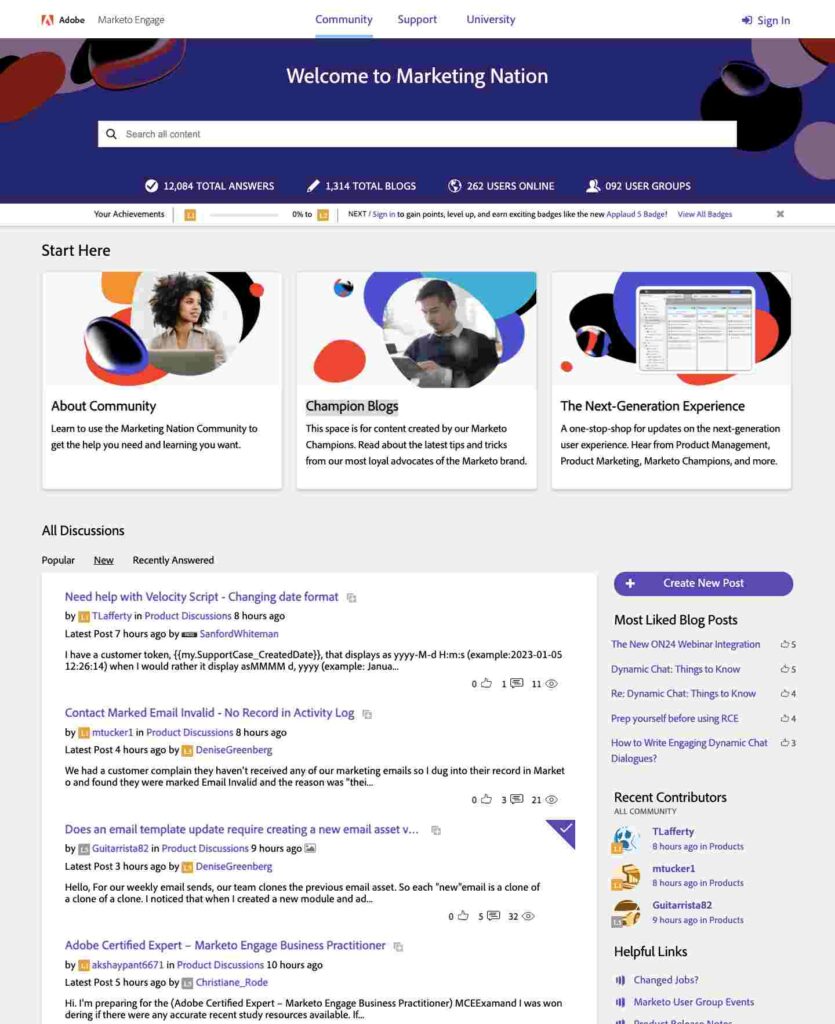
Community platforms and forums like these are commonly found on most SaaS websites today. If you’ve read our Airtable content marketing case study, you’ll find that Airtable has something similar where the Airtable community can engage with practical and actionable content.
Now, you might be wondering – what is it that makes Marketo’s community forum unique? Besides the main blog and the CMO Nation section for all the thought leadership content, they also have a Marketo Champions Blog. This is a space for Marketo Champions to post their own blog posts. Who are Marketo Champions? These are users and brand ambassadors from around the world who are a part of the Marketo Champions program that started almost 10 years back to recognize the top contributors in the community. Besides sharing their expertise on the blog, they also get speaking opportunities at Marketo events, exclusive access to product and marketing teams meetings, early previews of the latest feature updates, and more.
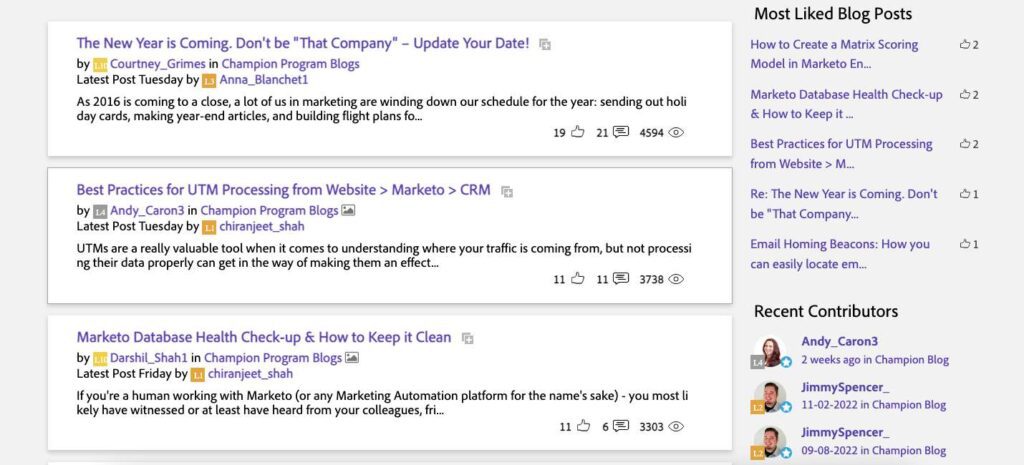
The Marketo Champions Program is an example of an ingenious way to build a community around your product, while also leveraging user generated content at the same time. By giving a voice to their users in the wider customer ecosystem, they are essentially allowing their users to market the product rather than doing all the heavy lifting themselves.
7. Customer stories as case studies
With concerted content marketing efforts and continuous product improvement, Marketo has managed to rope in some pretty big clients, like Fujitsu, Panasonic, and Roche Diagnostics. While knowing that these brands trust Marketo for their needs would be enough for some audiences, Marketo goes one step further to show just how these brands benefited from their product. And what better way to do that than case studies? These case studies can be found in their resources tab, under ‘Customer Stories’.
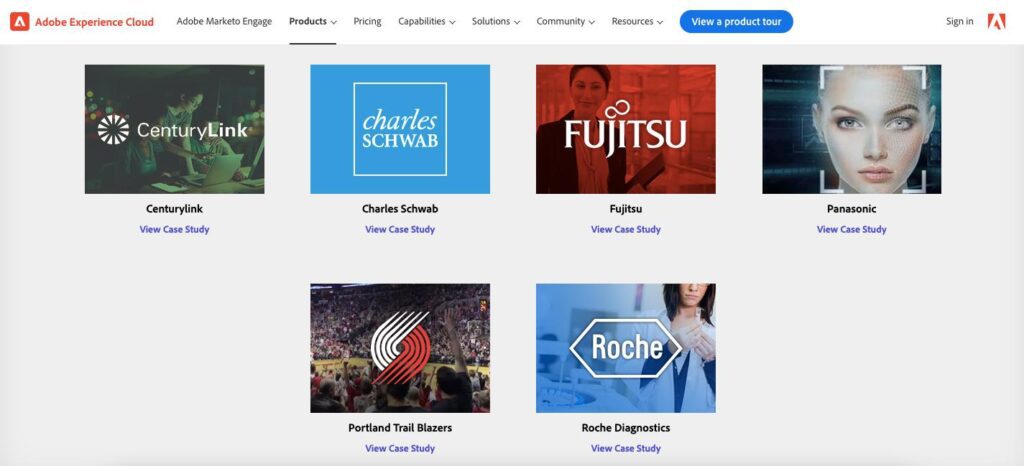
As you open each client case study, you are presented with a detailed overview of the marketing challenges faced by the company, and how Marketo helped them overcome them. They’ve also added a video with each case study, with the key stakeholder of the marketing operations explaining how they’ve benefited from Marketo.
These customer case studies are a beautiful example of just how well Marketo does its brand storytelling. By building a story around their product and customers, they’re able to demonstrate how well their product works.
We, at Narrato, also use client case studies to explain the various use cases of our product. In this Narrato case study, for instance, we show how Narrato helped an Indian startup Park+ scale its content production by 6x.
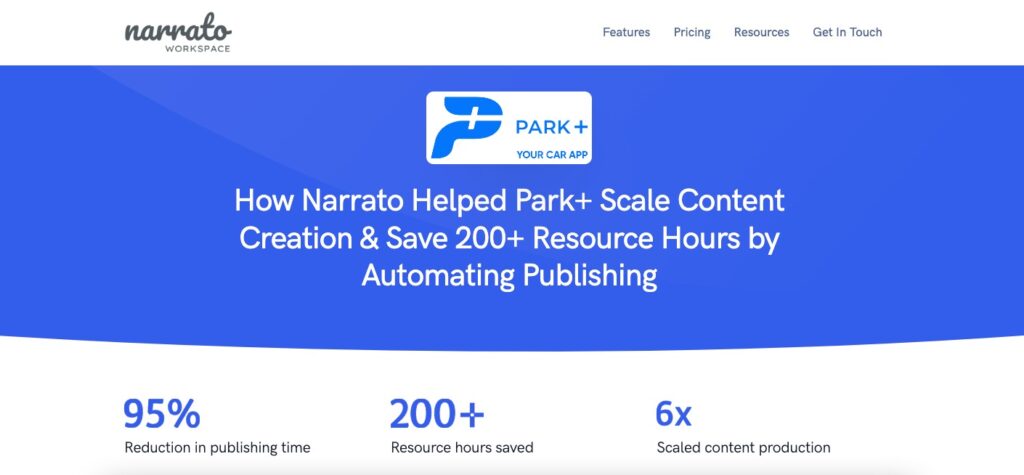
Case studies and customer stories are a critical part of any SaaS content marketing strategy. We’ve seen this in our Notion content marketing strategy case study too, how they share these stories as ‘Inspiration’.
8. Webinars and events
Webinars are probably the best for reaching out to new customers and building relationships with existing ones, especially for SaaS companies They’re inexpensive, convenient, educational, and excellent for lead generation. Marketo understood this well, which is why it has a whole page dedicated to webinars, which are available on demand.
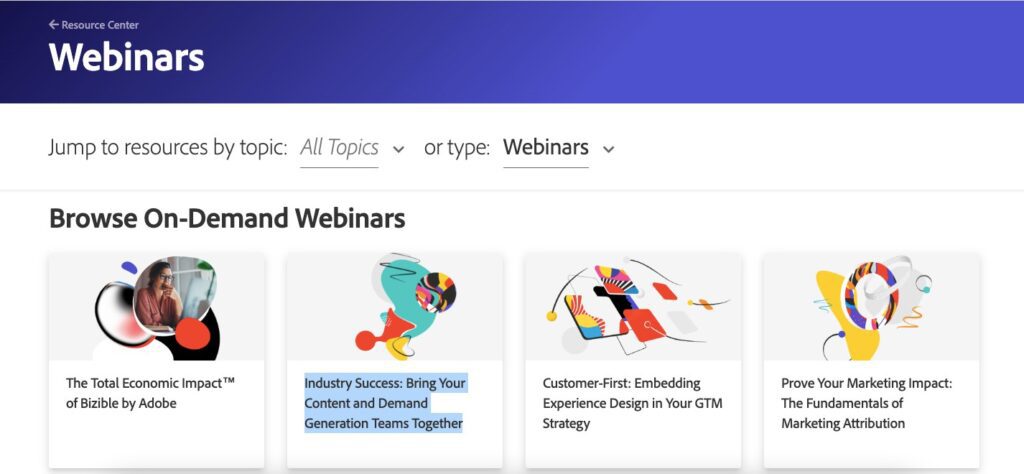
Besides webinars, it also holds annual conferences, like the Adobe Summit – The Digital Experience Conference, and other events from time to time to keep its users and audience engaged. And the audience also benefits from these events when they get to learn something new from the industry leaders.
While we’re on the topic of content marketing conferences, there is a great lineup of content marketing conferences for 2023. Don’t forget to check it out.
9. Marketo’s social media presence
Like most modern SaaS companies, Marketo leverages all social media channels, including LinkedIn, Instagram, and Twitter. Most of their social media content focuses on marketing tips, event announcements, blog promotions, feature updates, and more. Marketo also tries to keep its content relevant to the social media platform. Take their Instagram page, for example. They use a lot of interesting graphics and bright visuals on this platform, while their posts on Linked and Twitter are more factual.
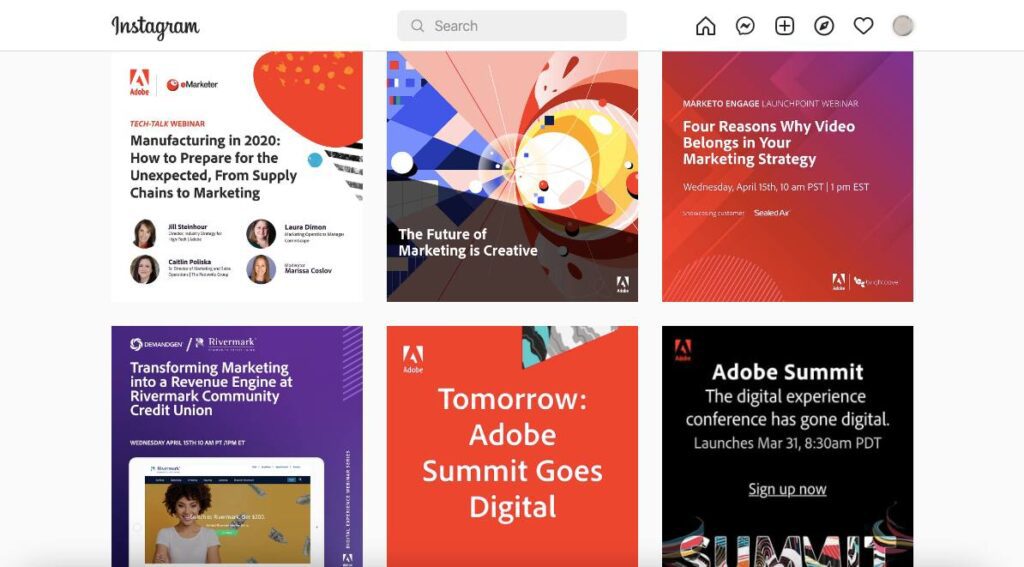
But unlike HubSpot, Semrush, or Monday.com content marketing strategy, Marketo does not produce a lot of relatable content in the form of memes, GIFs, or reels. They’re also not very active on YouTube. It’s evident that their focus is on providing relevant and succinct information to their users, and not running after virality.
10. Marketo University
You might think we’ve covered it all, but wait, there’s still one aspect of the Marketo content marketing strategy left. If the Marketo blogs, guides, webinars, events, and other useful resources weren’t enough, they also have their own set of educational resources for those interested in taking their content marketing skills to the next level.

And the unique thing here is that they take a product-led approach with these educational resources too. While giving practical advice and marketing tips, each course also explains how users can get the most value out of Marketo products.
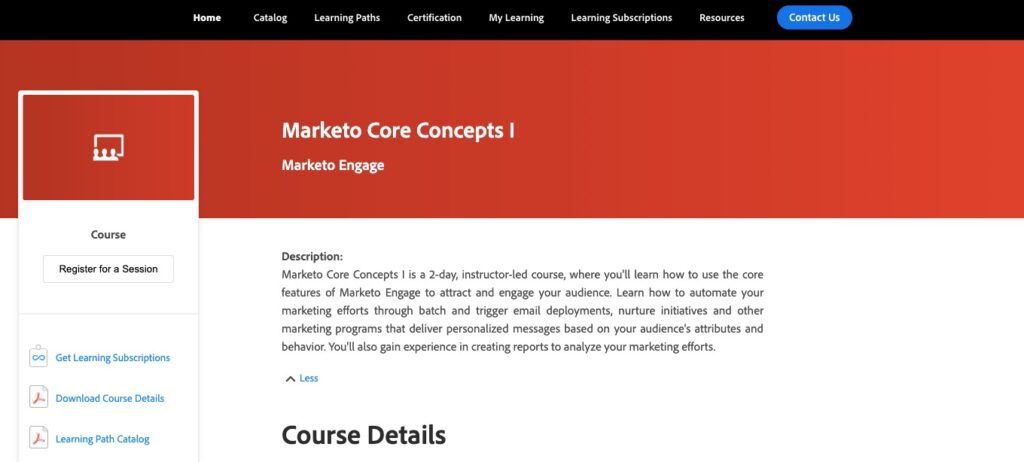
What we learned from the Marketo content marketing strategy
The goal of content marketing is to attract, engage and convert prospects into paying customers, and Marketo has been able to accomplish this beautifully over the years. Here are some of the key takeaways from this content marketing case study on Marketo’s content marketing strategy that we’d like to highlight –
- Start building your blog with useful resources even before you’ve launched your product. This way, the audience is already familiar with your brand when you do launch the product.
- Use product-led content marketing to make the product hero of the content. Take every chance to weave a story around your product, but do it intelligently.
- Empower your audience with educational resources, success kits, useful guides, webinars, and more to keep them engaged. Retaining your existing customers is just as important as attracting new ones.
- Build a community around your product, but also consider giving them a voice on your platform. Besides gaining brand ambassadors for your product, you’ll also be able to gain valuable feedback that’ll help you improve.
Looking for an alternative to Marketo for your content marketing needs?
Marketo is a great platform to streamline and automate marketing tasks, but if you are looking for something more targeted toward fulfilling all your content needs, why not try Narrato? This AI content planning and creation platform can help you with everything in the lifecycle of content, from its planning and creation to publishing. Besides, it is also an excellent team and project management platform that allows you to keep track of everything little thing in your content marketing operations. What’s better is that Narrato doesn’t come with a steep learning curve, so you can get your team onboard the platform fairly quickly.





